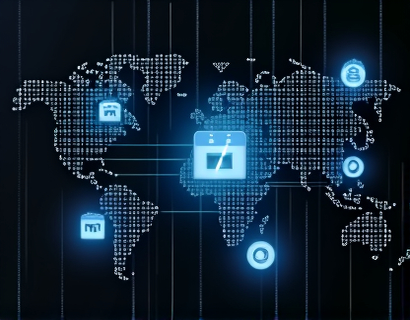Blockchain-Powered Asset Tokenization: Transforming Real-World Assets for Enhanced Market Accessibility and Liquidity
The integration of blockchain technology into the realm of asset management is ushering in a new era of financial innovation. By leveraging the inherent characteristics of blockchain, such as transparency, security, and decentralization, real-world assets are being transformed into digital tokens. This process, known as asset tokenization, is revolutionizing the way assets are traded, managed, and accessed, offering unprecedented liquidity and market accessibility.
Asset tokenization involves converting tangible or intangible assets into digital tokens on a blockchain network. These tokens represent a fraction or the entirety of the underlying asset, which can range from real estate properties and artworks to commodities and corporate shares. The tokenization process enables these assets to be traded on blockchain-based platforms, breaking down traditional barriers and opening up new opportunities for investors and asset owners alike.
Enhancing Liquidity through Tokenization
One of the most significant benefits of asset tokenization is the enhancement of liquidity. Traditional assets, particularly illiquid ones like real estate and art, often require substantial time and resources to buy or sell. Tokenization addresses this issue by breaking down these assets into smaller, tradable units. This granularity allows for more frequent and smaller transactions, making it easier for investors to enter and exit positions without significant disruptions to the asset's value.
For instance, a commercial property worth millions can be tokenized into thousands of smaller units, each representing a fraction of the property's value. This division enables a broader range of investors to participate, from individual retail investors to institutional funds. As a result, the asset's overall liquidity increases, leading to more active trading and potentially higher price discovery.
Increasing Market Accessibility
Asset tokenization also democratizes access to investment opportunities. Traditionally, high minimum investment requirements and complex regulatory frameworks have limited the number of individuals who can invest in certain assets. Tokenization removes these barriers by reducing the minimum investment to a token's value, often as low as a few dollars. This democratization empowers a wider audience, including retail investors, to participate in markets previously reserved for high-net-worth individuals and institutional investors.
Moreover, the global nature of blockchain networks means that tokenized assets can be accessed and traded by anyone with an internet connection, regardless of geographical location. This global reach not only increases the potential investor base but also fosters a more diverse and dynamic market environment.
Improving Transparency and Trust
Blockchain's inherent transparency is a game-changer for asset management. Every transaction involving tokenized assets is recorded on the blockchain, creating an immutable and verifiable ledger. This transparency reduces the risk of fraud and errors, as all parties can independently verify the asset's ownership and transaction history. The tamper-proof nature of blockchain ensures that once a transaction is recorded, it cannot be altered, enhancing trust among market participants.
Additionally, smart contracts, which are self-executing contracts with the terms directly written into code, can automate and enforce the rules of asset transactions. These contracts reduce the need for intermediaries, lowering transaction costs and speeding up the process. The automation of routine tasks also minimizes human error, further improving the reliability of the system.
Tokenized Assets: A New Asset Class
Tokenized assets represent a new asset class that combines the characteristics of traditional assets with the benefits of digital technology. This hybrid nature opens up a myriad of possibilities for asset management and investment strategies. For asset managers, tokenization offers new ways to create and manage portfolios, enabling more flexible and diversified investment products. For investors, it provides access to a broader range of assets with potentially higher returns and lower risks.
The tokenized asset class also facilitates the creation of new financial instruments, such as fractional ownership in high-value assets, revenue-sharing models, and collateralized lending. These innovations can lead to more efficient capital allocation and better risk management, ultimately benefiting the entire financial ecosystem.
Use Cases of Asset Tokenization
To better understand the practical applications of asset tokenization, let's explore some real-world use cases:
- Real Estate: Commercial and residential properties can be tokenized, allowing multiple investors to own fractions of a property. This model can increase liquidity and reduce the barriers to entry for real estate investing.
- Art and Collectibles: High-value artworks and collectibles can be tokenized, making it easier for enthusiasts to invest in and trade these unique items. This tokenization can also help verify authenticity and provenance.
- Commodities: Commodities like gold and oil can be tokenized, providing investors with direct exposure to these assets without the need for physical storage or handling.
- Corporate Shares: Equity tokens can represent fractions of company shares, enabling smaller investors to participate in the growth of startups and established firms.
- Intangible Assets: Intellectual property, such as patents and copyrights, can be tokenized, facilitating licensing and royalty payments in a more efficient and transparent manner.
These use cases demonstrate the versatility of asset tokenization and its potential to transform various sectors by enhancing liquidity, accessibility, and transparency.
Challenges and Considerations
Despite its numerous advantages, asset tokenization is not without challenges. Regulatory uncertainty remains a significant hurdle, as different jurisdictions have varying approaches to blockchain and tokenized assets. Compliance with securities laws, anti-money laundering (AML) regulations, and know-your-customer (KYC) requirements is crucial to ensure the legitimacy and sustainability of tokenization projects.
Technical challenges also exist, such as scalability and interoperability of blockchain platforms. As the number of tokenized assets grows, the blockchain network must handle increased transaction volumes efficiently. Additionally, ensuring seamless integration between different blockchain systems is essential for a cohesive and user-friendly market.
Another consideration is the security of tokenized assets. While blockchain itself is secure, the interfaces and applications built on top of it can be vulnerable to attacks. Robust security measures and continuous monitoring are necessary to protect against potential threats.
Future Prospects
The future of asset tokenization looks promising, with ongoing developments in blockchain technology addressing current challenges. Advancements in scalable blockchain solutions, such as layer 2 protocols and cross-chain interoperability, will enhance the performance and usability of tokenized asset markets.
Moreover, increased regulatory clarity and collaboration between governments and blockchain stakeholders will help establish a stable and supportive environment for tokenization. As more institutions adopt and integrate blockchain-based asset management solutions, the market is expected to grow, attracting even more innovation and investment.
In conclusion, blockchain-powered asset tokenization is transforming the landscape of asset management by enhancing liquidity, increasing market accessibility, and improving transparency. By breaking down traditional barriers and leveraging the unique features of blockchain, tokenization opens up new opportunities for both asset owners and investors, paving the way for a more inclusive and efficient financial ecosystem.










































